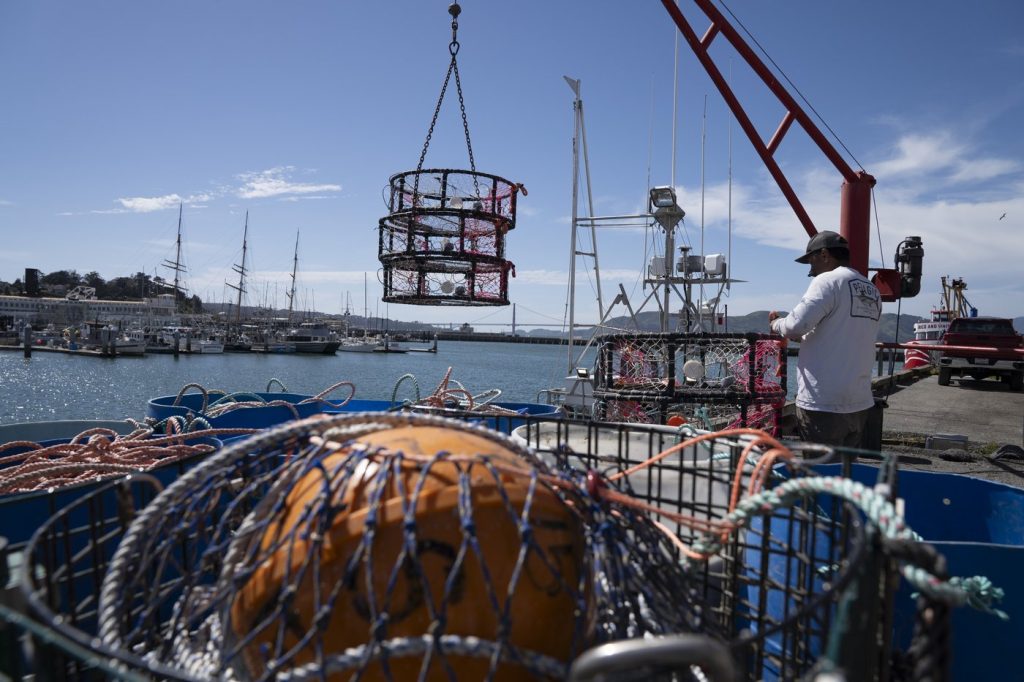After years of a shortened crab fishing season aimed at preventing whale entanglements off the West Coast, California crabbers are now exploring a new fishing method that allows them to extend their time on the water while ensuring the safety of marine mammals. The state has initiated a pilot program in 2023 to test the use of innovative pop-up gear, which is designed to protect whales and address challenges faced by fishermen. Full authorization for this gear is expected by spring 2026 for the Dungeness crab fishing season.
The pop-up gear utilizes a remote device to retrieve lines that are laid horizontally across the ocean floor, eliminating the need for vertical lines that pose risks to migrating whales. This technology is also being tested in other regions, including for lobster fishing in Maine, black sea bass in Georgia, and various fisheries in Australia and Canada.
Brand Little, a crab fisherman from San Francisco participating in the pilot, expressed his frustration with past restrictions: “Unfortunately, it has been six years we’ve been delayed or closed early for whales. This is a way to get our industry back," he stated. The motivation behind this initiative stems from a significant increase in whale entanglements reported off the Pacific Coast about a decade ago. The marine heat wave drove many whales, primarily the endangered humpback species, closer to the California coast in search of food, where they became entangled in vertical fishing lines connecting crab pots to surface buoys.
In response to this alarming trend, California state regulators implemented rules prohibiting Dungeness crab fishing whenever whales were known to be present, resulting in a drastically shortened fishing season and leaving fishermen with very limited opportunities to earn a livelihood. The development of pop-up gear emerged as a potential solution to restore balance within the industry while protecting vulnerable whale populations. Fishermen who have begun to experiment with this new method have reported promising results, leading them to believe the benefits outweigh the costs.
The innovative gear allows fishermen to use an acoustic release device to bring crab pots up from the ocean floor, without the need for tethering to a buoy. This design enables fishermen to lay pots horizontally, allowing whales to migrate freely over them. Ryan Bartling, a senior environmental scientist supervisor with the California Department of Fish and Wildlife, emphasized that this method removes the entanglement risk associated with vertical lines and helps maintain fishery activities.
Despite the potential advantages, many experienced Dungeness crab fishermen have been hesitant to adopt the pop-up gear due to the high costs associated with the devices, which can reach $1,000 each, plus additional onboard units required for operation. Furthermore, there is a logistical challenge in reorganizing the pots after the intense winter fishing seasons when crab fishermen work under the pressure of rapid harvests coinciding with whale calving seasons in warmer southern waters.
Additionally, the suitability of a unified tracking system for monitoring these devices is critical, as they lack visibility on the ocean's surface. The National Oceanic and Atmospheric Administration reported that in 2015 alone, over four dozen whales were entangled in fishing nets, a steep rise compared to an average of only 10 annually in previous years. Most of the affected whales were humpbacks, which have been recovering since receiving protective measures in the 1970s.
In light of ongoing challenges, environmental advocates took legal action against California due to rising entanglement incidents, culminating in a settlement that supported the adoption of ropeless gear. Bart Chadwick, an innovator and owner of San Diego-based Sub Sea Sonics, has utilized similar pop-up technology for environmental projects at sea. After retirement, he adapted the system for fishing, noting that it allows access to fishing grounds previously off-limits and reduces gear loss.
Currently, most Dungeness crab fishermen tend to profit during the early segment of the fishing season when there are typically fewer whale sightings along the California coast. Experts believe the pop-up gear may not be viable during this period due to congestion in fishing activities, leading its consideration strictly for the smaller spring season starting on April 16 in central California.
Geoff Shester, a senior scientist at the conservation organization Oceana, expressed optimism regarding the future of this technology, suggesting it could be embraced more broadly if fishermen find it effective and feasible. Crab fisherman Ben Platt, initially skeptical about the new methodology, has decided to participate in the pilot program due to the recent improvements that allow multiple pots to be connected, simplifying the process and reducing costs. However, he noted that many fishermen remain concerned about the transition and may be reluctant to fully adopt the change without solid results.
Ultimately, for fishermen like Stephen Melz from Half Moon Bay, California, extending their time on the water is essential for economic survival. He recalled earlier days when he would crab from November through the spring, but now he faces a harsh reality with a limited season and little margin for error. “Better than just sitting at the dock," Melz concluded, highlighting the critical nature of adapting to new practices in the industry.










